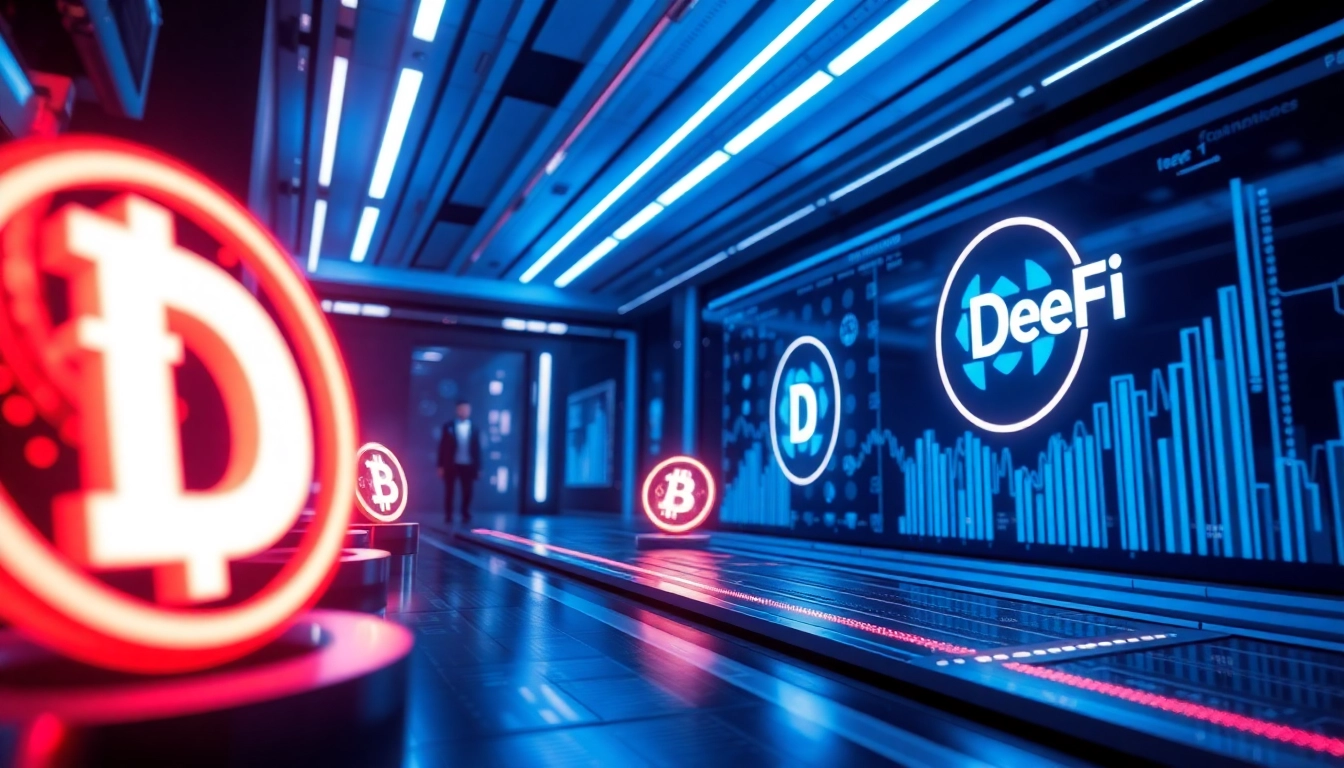Introduction to the Current DeFi Landscape
Decentralized Finance (DeFi) has rapidly evolved from a niche movement within the cryptocurrency ecosystem to a significant financial force reshaping traditional banking and investment paradigms. Driven by blockchain innovation, DeFi platforms facilitate lending, borrowing, asset management, and more, all without centralized intermediaries. As the industry matures, staying abreast of the latest DeFi updates is crucial for investors, developers, and regulators alike. For those seeking up-to-date insights, DeFi updates offer a comprehensive overview of ongoing developments, regulatory shifts, and technological breakthroughs shaping this dynamic sector.
Latest Trends and Highlights in DeFi Updates
Regulatory Changes and Impact (e.g., MiCA License)
Regulatory clarity remains one of the most pressing issues in the DeFi space. A notable recent development is Gemini’s successful acquisition of a Markets in Crypto-Assets (MiCA) license in Europe, signaling growing institutional acceptance and regulatory compliance. MiCA aims to establish a standardized framework for crypto assets across the European Union, fostering safer and more transparent operations for DeFi platforms and issuers. This development not only boosts investor confidence but also sets a precedent for other jurisdictions to adopt similar frameworks, encouraging DeFi innovation within a clear legal context.
Furthermore, regulatory focus is shifting toward consumer protection, anti-money laundering (AML), and combating the financing of terrorism (CFT) measures, which are now integrated into many DeFi protocols’ compliance procedures. Governments worldwide are increasingly advocating for in-depth regulatory oversight, which could lead to stricter operational standards but also foster wider adoption by providing legitimacy and security assurances.
Innovations in DeFi Protocols and Platforms
The DeFi ecosystem is witnessing a wave of innovation, with new protocols and platforms enhancing usability, scalability, and security. For example, Layer 2 solutions such as Optimism and Arbitrum are significantly reducing transaction costs and latency, making DeFi applications more accessible to a broader audience. Moreover, interoperability protocols like Polkadot and Cosmos are enabling seamless asset transfers across different blockchains, addressing the fragmentation challenge.
Decentralized autonomous organizations (DAOs) are also gaining prominence, allowing communities to govern protocols collectively. Projects like Aave and Compound have introduced new collateral types and liquidation mechanisms, optimizing lending markets and risk management. Such innovations demonstrate a shift toward more resilient and user-centric DeFi environments that are adaptable to emerging needs.
Security Challenges and Recent Hacks
Security remains a critical concern within DeFi, where exploits and hacks continue to pose threats to protocols and users. Recent incidents, such as flash loan attacks and smart contract vulnerabilities, have resulted in substantial financial losses, emphasizing the importance of rigorous security audits and best practices.
To address these challenges, many protocols are adopting formal verification methods, bug bounty programs, and multi-signature wallets to mitigate risks. Community-driven security initiatives, like Immunefi, provide platforms for coordinated vulnerability disclosures and response. Despite these efforts, continuous vigilance and improved security measures are essential for sustaining trust and protecting user assets.
Influences of Major Entities and Governance News
Fed’s DeFi Advocacy and Policy Shifts
The Federal Reserve’s recent statements favoring decentralized financial technologies reflect a cautious but open approach toward integrating DeFi principles into the traditional financial system. For example, Fed Governor Lisa Cook highlighted the potential benefits of DeFi for enhancing payment efficiency and financial inclusion, prompting regulatory discussions on how to best oversee this sector.
This advocacy indicates a shift in US regulatory attitudes, moving from skepticism to a more nuanced understanding that could pave the way for pilot projects or official guidelines. Recognizing the transformative potential of DeFi, regulators aim to balance innovation with safeguards to prevent systemic risks, affecting how DeFi projects evolve and align with mainstream financial policies.
Crypto Regulatory Licenses and Compliance Updates
Beyond MiCA, other jurisdictions are advancing licensing regimes that impact DeFi protocols. In the US, the Commodity Futures Trading Commission (CFTC) has announced the launch of its second crypto sprint, focusing on regulatory frameworks for derivatives trading and DeFi participation. These initiatives aim to clarify legal boundaries, prevent malicious activities, and promote sustainable growth.
Globally, numerous exchanges and DeFi platforms are proactively obtaining licenses to demonstrate compliance, attracting institutional investors seeking regulatory clarity. Such compliance initiatives serve as logic checks for DeFi developers and users, ensuring adherence to evolving standards and fostering a more integrated financial landscape.
Key Player Movements and Strategic Alliances
Major DeFi players are forming alliances to pioneer new solutions and expand their ecosystems. For instance, collaborations between blockchain projects, financial institutions, and analytical firms enable sophisticated data analytics, improved liquidity pools, and enhanced user experience. Notably, new partnerships are focusing on cross-border DeFi lending, asset tokenization, and institutional-grade security protocols, all critical for mainstream adoption.
Practical Implications for Investors and Developers
How to Leverage DeFi Updates for Investment Strategies
Staying informed through platforms like Coin Medium allows investors to act swiftly on emerging opportunities, such as new lending pools, yield farming innovations, or regulatory-approved protocols. Analyzing trends like increasing TVL (Total Value Locked) or protocol upgrades can indicate future growth potential.
Diversification is vital; monitoring DeFi news helps identify promising assets early. Additionally, understanding security developments ensures investments are made into protocols emphasizing safety and transparency, reducing risk exposure.
Implementing Security Best Practices in DeFi Projects
Developers should adopt comprehensive security strategies, including regular audits, formal verification, and community bug bounty programs. Establishing transparent governance models and multi-signature controls also reduces vulnerability. Learning from recent exploits underscores the importance of proactive risk mitigation and continuous security improvements.
Tools and Resources for Staying Ahead in DeFi
Utilize analytics and tracking tools such as De.Fi, DappRadar, and CoinGecko for real-time data on protocol performance, market movements, and upcoming launches. Participating in DeFi-focused forums and news aggregators keeps you informed on regulatory developments and technological advancements, enabling swift adaptation to industry changes.
Future Outlook and Emerging Opportunities in DeFi
Upcoming Projects and Web3 Innovations
Web3 projects are on the brink of launching new metaverse integrations, NFT marketplaces, and Layer 3 solutions, promising enhanced scalability and user engagement. Upcoming DeFi platforms are emphasizing sustainability, with greener protocols and energy-efficient consensus mechanisms gaining traction.
Predictions for DeFi Market Movements
Given the recent regulatory progress and technological advancements, DeFi is poised for accelerated growth in 2025. Institutional involvement is expected to increase, driven by the deployment of compliant infrastructure and security measures. Market capitalization could potentially triple, with innovative sectors like cross-chain DeFi and synthetic assets leading the charge.
Strategic Tips for Navigating Rapid Industry Changes
To succeed in this fast-paced environment, participants should prioritize continuous education, diversify across protocols, and maintain rigorous security protocols. Building resilience through strategic partnerships and leveraging data insights will enhance adaptability and long-term success in DeFi markets.


